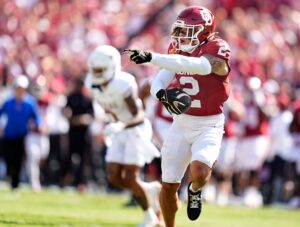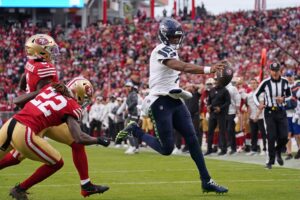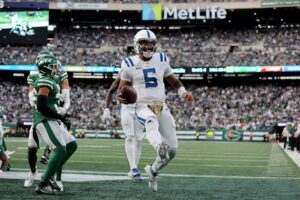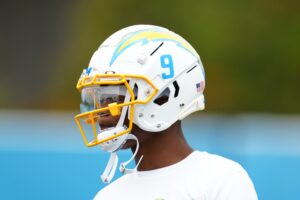The New England Patriots received a 4th round compensation pick for the 2017 draft, and that bodes incredibly well for New England. The Patriots mid-round selections have been the backbone of the two most recent Super Bowl championships. While the third round has provided several great players, the fourth round might be even better. Let’s take a look back on the recent New England Patriots fourth round draft history.
Diamonds in the Rough: New England Patriots Fourth Round Draft History
2017: Deatrich Wise, Jr., 131st Overall
Wise was the only drafted rookie to make an impact on the 2017 Patriots, and he played a big role. Wise became a crucial player on the edge due to a rash of injuries to edge defenders along with the retirement of Rob Ninkovich. He wasn’t perfect by any means, but the fourth round rookie looks like he could be a longtime fixure along the defensive line.
Wise’s rookie season played out very similar to that of former Patriot Chandler Jones. Wise finished his rookie year with five sacks and 26 combined tackles. He struggled to set the edge against the run, but was probably the second best pass rusher on the team, behind Trey Flowers. By comparison, Jones finished his rookie season with six sacks and 45 combined tackles. Like Wise, Jones was weak against the run but was one of the best pass rushers on that 2012 squad. Wise doesn’t have the ceiling Jones has, but he definitely has what it takes to be a longtime starter along the offensive line.
2016: Malcolm Mitchell, 112th Overall
He’s only had one healthy season, but man did Malcolm Mitchell impress in 2016. It’s notoriously difficult to be rookie receiver on the Patriots. New England has one of the most elaborate and complex playbooks in the league, and if you don’t have Tom Brady’s complete trust, you won’t get the ball. Mitchell overcame that to put up 32 receptions for 401 yards and four touchdowns in his first season. All in all, he had probably the third greatest season for a rookie wide receiver under Brady, only to Aaron Dobson and Deion Branch.
The question going forward is will Mitchell’s career be more like Dobson or Branch? Dobson’s production was born more out of necessity because there was no receiving talent on that offense. Branch, meanwhile, turned his rookie success into an 11-year NFL career. Injuries wiped away Mitchell’s 2017, so we’re still waiting on that answer. However, there’s plenty of reasons to believe Mitchell’s career will look more like Branch’s.
Mitchell showed the skills to be a great perimeter receiver his rookie season. Specifically, he excelled at hauling in tight, contested catches. His best game of the season likely came when he scored two touchdown against Darrelle Revis, including the game-winning score. He was also huge in Super Bowl 51, as his presence opened up the passing game. Without him, New England might not have been able to pull off that 25-point comeback.
Currently, Mitchell remains the only receiver capable of consistently winning those outside matchups. Assuming he’s 100% healthy for the start of 2018, there’s no reason to think Mitchell can’t usurp Chris Hogan as the number two receiver on the team.
2015: Trey Flowers, 101st Overall
No draft pick comes close to being as good as taking Tom Brady with the 199th pick, but the Flowers pick is in the running for the second best draft steal of the Belichick Era. While that honor would probably go to taking Julian Edelman in the seventh round, Flowers has become an absolute force on defense. He was easily the best pass rusher on the team last year, and was arguably the best defensive player on the roster.
Flowers missed all but one game of his rookie season, but has stayed healthy ever since. Flowers started 2016 coming off the bench, but became a starter midway through the season. Once he got the starting spot, he didn’t relinquish it. Flowers recorded seven sacks in the second half of 2016, and was a big factor in fixing the 2016 defense. The Atlanta Falcons had no answer for Flowers in Super Bowl 51, as he finished his night with 2.5 sacks. 1.5 of those sacks came on third down, and the other one was the sack which pushed Atlanta out of field goal position in the fourth quarter.
Flowers proved he wasn’t a one-year wonder in 2017. His 6.5 sacks weren’t overly impressive, but he did a lot that didn’t show up on the stat sheet. Flowers was basically the only edge player that could play both the pass and the run. The 2017 run defense was bad, but it would have been atrocious without Flowers. Additionally, Flowers was far and away the best pass rusher on the roster, so opposing teams would put more attention on him. Flowers constantly faced double-team blocks, yet he still found a way to produce. Flowers easily has double-digit sack potential if Wise or another edge rusher can step up.
2015: Tre’ Jackson, 111th Overall
Well, they can’t all be winners. Jackson was drafted to fill a desperate need on the 2015 Patriots. New England’s offensive line was easily the biggest weakness of the 2014 Patriots, so Jackson was expected to be an immediate starter.
At first, that’s exactly what Jackson was. Jackson started the first seven games of the season, primarily playing right guard. He was a little too slow on his feet and needed some work, but he performed fine, all things considered.
Jackson’s career took a downward turn in Week Seven against the Miami Dolphins. The rookie guard suffered a nasty knee injury that kept him out of the next four games. Jackson came back, but he clearly wasn’t the same the rest of the season. The 2015 Patriots had an absurd amount of injuries, and Jackson was thrust back into the lineup without ever fully recovering.
The weight of that decision bore down the following off-season. That same knee injury kept Jackson on the Physically Unable to Perform list, causing him to miss all of 2016. Jackson wouldn’t suit up again for the Patriots, getting released in April of 2017. As of this posting, Jackson has not played an NFL snap since his rookie season.
Would Jackson have become an NFL caliber player were it not for that knee injury? Who knows. He wasn’t great in 2015, but he wasn’t outwardly terrible either. Regardless, that knee injury against Miami and the subsequent effort to play through it likely cost him any chance at a career. The pick ultimately didn’t work out, but it was due mostly to bad luck and poor circumstances.
2015: Shaq Mason, 131st Overall
The Patriots double-dipped at guard in the 2015 draft with the Mason selection. While the Jackson pick didn’t work out, the Mason one was a home run. Mason was drafted out of a triple-option college offense. Essentially, he has never pass blocked in his career, so he was something of a project.
The Patriots drafted him knowing it would be roughly a year before he reached his potential. Mason started off the 2015 season coming off the bench in clear running situations. The one benefit to him not knowing how to pass block is that he was an absolute monster as a run blocker. For the first few weeks of the season he was used almost exclusively on running plays.
However, when injuries struck, Mason was thrown into the regular lineup and was tasked with learning pass blocking on the fly. He played left guard throughout most of the regular season. However, he switched to right guard in the playoffs, and the change suited him.
Since switching to the right side of the line, Mason has been one of the best guards in football. His run blocking, which was good to begin with, has only gotten better. He never gets pushed back and is great as a pull guard on runs to the left. His pass blocking isn’t as good as his run blocking, but he’s still above average at that too. Altogether, he’s probably the best lineman the Patriots have.
2014: Bryan Stork, 105th Overall
Like Jackson, Stork’s career was ruined before it could ever really start. He only played in New England for two seasons, and David Andrews has done a great job replacing him, but Stork made a huge impact when in the lineup.
The Patriots offensive line could not block through the first four weeks of 2014. The run game had no holes to run through, and Brady was constantly under pressure. Stork started the season on the bench after missing a sizable chunk of training camp. However, when he was finally allowed to start, he performed admirably.
The offensive line was never the strength of that Patriots team, but Stork’s presence helped make it a league average unit. Brady finally had time in the pocket, and reverted back to his normal, dominating form. Stork himself was a little undersized and struggled blocking larger linemen, but he was still a league average starting center.
Unfortunately for Stork, concussion issues continued to haunt him. Stork missed the first eight weeks of 2015 with another concussion, allowing Andrews to emerge. While Stork regained the role for the second half of 2015, they entered training camp in an open competition. Stork would suffer yet another concussion, and eventually retired due to the head injuries.
2014: James White, 130th Overall
It’s safe to say this pick worked out. White has been an absolute steal, establishing himself as one of the best third down backs in football. It’s funny to think back on it now, but he could barely make it on the game day roster for the first year and a half of his Patriots tenure.
White has only been active for nine games prior to Dion Lewis’ season-ending ACL injury in 2015. When White finally made his way onto the field, he had mixed results. At first, he looked like an absolute monster in the receiving game. Julian Edelman went down one week after Lewis, and White was basically the best receiver left standing in 2015. White was able to gain separation regardless of who was covering him, and was basically the only functioning part of the passing offense late in 2015.
However, he struggled running the ball, which is a bad trait for a running back. White averaged an ugly 2.5 yards per carry in 2015. Opposing teams soon caught on to White’s weakness, and knew his presence on the field signaled a pass play.
White’s Continued Development
Lewis was still recovering from his ACL injury at the beginning of 2016, giving White another shot to earn his role as third down back. This time, White made the most of his opportunities. While he wasn’t Barry Sanders, White was able to provide just enough of a threat in the running game so that teams couldn’t lock in on the pass. He played so well that he kept the third down role even once Lewis returned to the lineup.
Of course, his biggest performance came in Super Bowl 51. White put up a historic performance, catching 14 passes for 110 yards and a touchdown. He also played a big role in the running game, putting up 29 yards, two touchdowns and a two point conversion. White’s 14 receptions and 20 points scored remain Super Bowl records. Outside of Brady, White was most responsible for that incredible comeback.
He was rewarded for his efforts with a three-year contract extension, and White rewarded the faith with a solid 2017. He didn’t see quite as much of the field as expected due to Lewis’ crazy production, but he should remain one of the best third down backs moving forward.
2014: Cameron Fleming, 140th Overall
While most of these fourth round picks have vastly exceeded expectations, Fleming is what you expect to get out of a late fourth round pick. Fleming has been a serviceable backup tackle throughout his New England tenure, and he’s provided crucial depth throughout his Patriots tenure. Fleming entered the 2018 off-season as a free agent, and ended up signing a one-year deal with the Dallas Cowboys.
Keep an eye out for whoever the Patriots draft in the fourth round, because they’ll probably be a stud. In a round normally used for filling out depth, Belichick has found key contributors and outright superstars. Belichick has found three starters, three solid contributors, and two players whose careers were lost to injury. Everyone but Jackson and Stork are still with the team, and everyone but Jackson played a role in bringing home at least one of the two most recent championships
Main photo:
Embed from Getty Images






